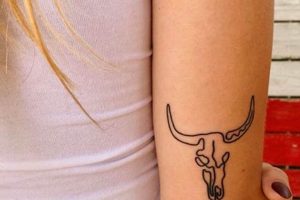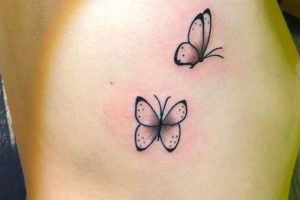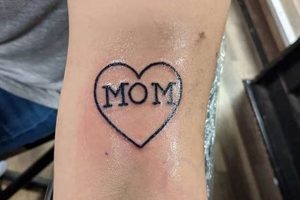Minimalist body art frequently involves clean lines, small designs, and often symbolic imagery. Examples include single-word inscriptions, geometric shapes, small outlines of animals or flowers, and minimalist line drawings. These designs prioritize clarity and impact over intricate detail.
Choosing less complex artwork offers several advantages. Smaller tattoos typically involve shorter application times and faster healing. Their understated nature makes them versatile and easily adaptable to various body placements. Historically, even ancient cultures practiced simpler forms of tattooing, often with symbolic or tribal significance. The current interest reflects a modern appreciation for clean aesthetics and personal expression without extensive commitment.
Factors to consider when selecting a design include personal meaning, placement on the body, and the artist’s style. Further exploration of these considerations will provide a comprehensive understanding of this increasingly popular form of self-expression.
Tips for Choosing a Simple Tattoo
Careful consideration of several factors contributes to a successful and satisfying tattoo experience. The following tips offer guidance in selecting a design and ensuring its longevity.
Tip 1: Research Symbolism: Images hold cultural and historical significance. Thorough research prevents unintended interpretations.
Tip 2: Consider Placement: Visibility and body contours influence a design’s impact. Placement should complement both the design and the individual’s physique.
Tip 3: Prioritize Simplicity: Intricate details may not translate well in smaller designs. Clean lines and bold shapes often age more gracefully.
Tip 4: Choose a Reputable Artist: An experienced artist specializing in minimalist designs understands the nuances of fine lines and precise execution.
Tip 5: Plan for Aftercare: Proper healing is crucial. Follow the artist’s aftercare instructions diligently to maintain the tattoo’s integrity.
Tip 6: Reflect on Longevity: Tattoos are permanent. Consider how the chosen design might evolve with time and changing personal aesthetics.
Tip 7: Start Small: A small, simple design provides valuable experience and informs future tattoo decisions.
By considering these guidelines, individuals can make informed decisions that result in aesthetically pleasing and personally meaningful body art.
These considerations contribute to a positive and lasting experience, ensuring the chosen design remains a source of personal satisfaction.
1. Meaningful Symbols
Meaningful symbols form the core of many simple tattoo designs. The power of these designs often lies not in intricate detail, but in the evocative nature of the chosen symbol. A single image can encapsulate a complex idea, belief, or memory, making it a potent form of personal expression. For example, a small wave can represent overcoming challenges, a semicolon can symbolize resilience and mental health awareness, or a simple outline of a mountain range can signify a love of nature and adventure. The inherent simplicity of these symbols allows for versatile placement and enduring aesthetic appeal.
The selection of a meaningful symbol transforms a simple tattoo into a personal narrative. This connection allows individuals to carry a piece of their story with them, serving as a constant reminder of values, experiences, or aspirations. The minimalist nature of the design enhances this connection, ensuring the focus remains on the symbol’s intrinsic meaning rather than distracting embellishments. Practical considerations, such as size and placement, become integral to the design process, ensuring the symbol’s visibility and integration with the individual’s body. A small, symbolic tattoo placed on the inner wrist, for instance, becomes a private reminder, while a slightly larger design on the forearm can serve as a conversation starter and a visible expression of personal identity.
Incorporating meaningful symbols into simple tattoo designs elevates body art beyond mere aesthetics. It fosters a deeper connection between the individual and the design, transforming it into a tangible representation of personal significance. While simplicity remains key to the visual appeal and longevity of the tattoo, the chosen symbol imbues it with lasting meaning. This approach to tattoo design emphasizes intentionality and personal narrative, ensuring the design resonates deeply with the individual and remains relevant throughout their life.
2. Minimalist Aesthetics
Minimalist aesthetics play a crucial role in contemporary tattoo design, particularly within the realm of simple tattoo ideas. This design philosophy emphasizes clarity, conciseness, and the elimination of superfluous elements. It prioritizes essential lines, shapes, and negative space to create visually striking and enduring designs. This approach aligns perfectly with the desire for understated yet impactful body art.
- Reduction of Elements:
Minimalist tattoos often feature a limited color palette, typically black ink, and simplified forms. A single, unbroken line can depict a flower or a series of geometric shapes can form an abstract pattern. This reduction allows the core design elements to stand out, enhancing visual impact and longevity. Intricate details tend to blur over time, whereas bolder, simpler designs retain their clarity.
- Emphasis on Negative Space:
The strategic use of negative space, the area surrounding the tattoo, is a hallmark of minimalist design. This approach creates a sense of balance and allows the design to breathe. For example, a silhouette of a bird formed by negative space within a circle can be just as impactful, if not more so, than a fully rendered bird. This technique highlights the interplay between the tattoo and the skin itself.
- Precision and Clean Lines:
Minimalist tattoos rely heavily on precision and clean lines. A slight wobble or inconsistency can detract from the overall aesthetic. Therefore, selecting a skilled artist specializing in this style is essential. The crispness of the lines contributes to the tattoo’s longevity, ensuring the design remains sharp and well-defined over time.
- Focus on Symbolism:
Minimalism often goes hand-in-hand with symbolic imagery. A small, unadorned symbol can hold deep personal meaning, communicating a complex idea in a concise visual form. This focus on symbolism reinforces the minimalist aesthetic, prioritizing meaning over elaborate decoration. A simple anchor, for example, can represent stability and hope, while a single arrow can symbolize direction and purpose.
The convergence of these elements contributes to the timeless appeal of minimalist tattoos. By focusing on essential elements and precise execution, these designs offer a powerful form of self-expression that remains visually striking and personally meaningful for years to come. The inherent simplicity allows for seamless integration with the body, resulting in body art that feels both elegant and enduring.
3. Strategic Placement
Strategic placement is integral to the success of simple tattoo designs. A well-chosen location enhances the design’s impact, complements the individual’s physique, and ensures its visibility or discretion as desired. Careful consideration of placement elevates a simple design, transforming it into a cohesive and aesthetically pleasing element of personal style.
- Body Contours and Flow:
Placement should harmonize with the natural curves and lines of the body. A design that follows the contours of a collarbone, for example, creates a sense of flow and integration. Conversely, a design placed against the natural lines of the body can create a deliberate contrast. Understanding these dynamics allows for a seamless integration of the tattoo with the individual’s form.
- Visibility and Discretion:
Placement determines the degree to which a tattoo is visible. A design on the inner wrist offers a sense of privacy, while a tattoo on the forearm allows for greater visibility. Consideration of personal and professional contexts informs placement decisions, ensuring the tattoo aligns with lifestyle and social norms.
- Size and Scale:
The size of a simple tattoo influences its placement. Smaller designs lend themselves to delicate areas like the wrist, ankle, or behind the ear. Larger, minimalist designs may be better suited for areas like the forearm, back, or thigh. Proportional placement ensures the design complements the body part, avoiding a sense of imbalance or disproportion.
- Movement and Flexibility:
Areas of frequent movement or flexing can affect a tattoo’s appearance over time. Placement should consider the dynamic nature of the body. Designs placed on areas with minimal stretching, such as the outer wrist or ankle, tend to retain their integrity better than those placed on areas subject to significant movement, such as the inner elbow or knee.
Strategic placement maximizes the impact and longevity of simple tattoo designs. By considering the interplay between design, body contours, visibility, and movement, individuals can ensure their chosen artwork remains aesthetically pleasing and personally meaningful for years to come. The placement itself becomes an integral part of the design’s narrative, contributing to its overall impact and personal significance. A thoughtfully placed simple tattoo becomes more than just body art; it becomes a seamless extension of personal style and self-expression.
4. Clean Lines
Clean lines constitute a cornerstone of successful simple tattoo designs. Their precision and clarity are essential for achieving a minimalist aesthetic and ensuring the design’s longevity. The absence of blurring or wavering contributes significantly to the overall visual impact and enduring appeal of the tattoo. An exploration of the facets of clean lines reveals their integral role in minimalist body art.
- Definition and Impact:
Clean lines are characterized by their crispness, consistency, and lack of feathering or blurring. They create a sense of sharpness and precision, contributing to a polished and professional aesthetic. In simple tattoo designs, clean lines allow the core elements to stand out, enhancing visual impact. A simple outline of a geometric shape, for example, relies heavily on the precision of its lines to convey its form and maintain its visual integrity over time.
- Technical Execution:
Achieving clean lines requires a skilled artist with a steady hand and precise technique. The artist’s expertise influences the line’s consistency and sharpness. Factors such as needle selection, ink quality, and skin preparation contribute to the final result. A skilled artist understands the nuances of line work, ensuring the tattoo heals with crisp, well-defined lines.
- Longevity and Aging:
Clean lines contribute significantly to a tattoo’s longevity. Intricate details and shading tend to blur and fade over time, whereas bold, clean lines age more gracefully. This characteristic makes clean lines particularly well-suited for minimalist designs, ensuring the tattoo remains visually appealing for years to come.
- Aesthetic Contribution:
Clean lines contribute to a minimalist aesthetic by reducing visual clutter and emphasizing essential elements. This simplicity enhances the design’s impact and allows the viewer to focus on the core imagery. The absence of unnecessary details creates a sense of balance and sophistication, aligning with the principles of minimalist design.
The precision and clarity of clean lines are essential for achieving the desired aesthetic and ensuring the longevity of simple tattoo designs. By prioritizing clean lines, individuals can ensure their chosen artwork remains visually striking and personally meaningful for years to come. The emphasis on clean lines reflects a broader appreciation for minimalist aesthetics and the enduring power of simple, well-executed designs.
5. Personal Expression
Simple tattoo designs offer a powerful avenue for personal expression. The seemingly minimalist nature of these designs belies their capacity to convey profound meaning and reflect individual identities. A small, strategically placed symbol can speak volumes about one’s values, beliefs, experiences, or aspirations. This connection between personal expression and simple tattoo ideas arises from the ability to distill complex concepts into concise visual representations. A single word, a geometric pattern, or a minimalist outline of a meaningful object can encapsulate a personal narrative, transforming the body into a canvas for self-expression. For example, a small wave might represent a surfer’s connection to the ocean, while a delicate floral design could symbolize growth and resilience. The inherent simplicity of the design ensures the focus remains on the chosen symbol and its personal significance.
The process of selecting a simple tattoo design becomes an act of self-discovery. Individuals explore their values, passions, and experiences to identify the most fitting symbolic representation. The design’s placement further enhances this personal connection. A discreet tattoo on the inner wrist might serve as a private reminder of personal values, while a more visible design on the forearm could be a deliberate statement of self. The size and style of the tattoo also contribute to the narrative. A minimalist line drawing, for instance, might convey a sense of elegance and restraint, while a bold, geometric design could project confidence and individuality. The careful consideration of these elements transforms a simple tattoo into a powerful form of self-expression, communicating personal narratives without the need for elaborate or extensive artwork.
Ultimately, the enduring appeal of simple tattoo designs lies in their capacity to capture and convey personal narratives in a concise and impactful manner. The minimalist aesthetic ensures the focus remains on the chosen symbol and its personal significance, transforming a simple design into a lasting testament to individual identity. While trends in body art may evolve, the desire to express oneself through meaningful symbols remains constant. Simple tattoo designs provide a timeless and versatile medium for this expression, allowing individuals to curate their personal narratives on the canvas of their bodies.
6. Artist's Expertise
An artist’s expertise is paramount when realizing simple tattoo ideas effectively. While seemingly straightforward, minimalist designs require a high degree of technical skill and artistic sensibility. Precise line work, consistent saturation, and strategic needle depth are crucial for achieving the clean aesthetic that defines these tattoos. An experienced artist understands the nuances of minimalist design principles, including the interplay of negative space, the impact of line weight variation, and the importance of precise placement. For instance, a seemingly simple outline of a feather requires controlled line work to maintain its delicate nature and avoid appearing heavy or uneven. Similarly, a small geometric pattern necessitates precise spacing and consistent line thickness to achieve visual balance. Choosing an artist lacking this specialized skill set can result in a tattoo that appears amateurish or ages poorly.
Beyond technical proficiency, an artist’s expertise extends to their ability to translate a client’s vision into a tangible design. Effective communication, active listening, and a collaborative approach are essential for ensuring the final tattoo aligns with the individual’s expectations. Experienced artists specializing in minimalist tattoos possess a keen eye for detail and an understanding of how seemingly simple designs can convey complex meanings. They guide clients through the design process, offering valuable insights into placement, scale, and the potential longevity of different design elements. This collaborative process often involves refining initial concepts, suggesting alternative interpretations, and ensuring the chosen design harmonizes with the individual’s body and personal style. A skilled artist acts as a guide, helping clients navigate the complexities of minimalist design and ensuring the final result is both aesthetically pleasing and personally meaningful.
Selecting an artist based solely on price or convenience can compromise the integrity of a simple tattoo design. Investing time in researching artists specializing in minimalist aesthetics, reviewing their portfolios, and seeking consultations ensures a higher likelihood of achieving the desired outcome. A skilled artist’s expertise elevates a simple tattoo from a mere image on skin to a work of art that embodies personal expression, enduring quality, and technical precision. This investment in expertise ensures the simple tattoo idea translates into a timeless piece reflecting both the client’s vision and the artist’s skill.
Frequently Asked Questions
This section addresses common inquiries regarding minimalist body art, providing concise and informative responses.
Question 1: How much do simple tattoos typically cost?
Pricing varies based on factors such as size, placement, artist’s experience, and studio location. Obtaining quotes from multiple reputable artists is recommended.
Question 2: How long do simple tattoos take to heal?
Healing time typically ranges from two to four weeks, depending on individual factors and adherence to aftercare instructions.
Question 3: Are simple tattoos less painful?
Pain levels vary based on individual pain tolerance and tattoo placement. Generally, smaller tattoos involve shorter application times, potentially reducing overall discomfort.
Question 4: Can simple tattoos be easily covered up or removed?
Cover-ups and removals are possible but present greater challenges for intricate designs. Simple tattoos, due to their minimalist nature, offer more flexibility for future modifications.
Question 5: What are the best placement options for simple tattoos?
Optimal placement depends on individual preferences, lifestyle, and the specific design. Common choices include the wrist, ankle, forearm, and behind the ear. Placement should consider visibility, body contours, and potential impact on professional contexts.
Question 6: How does one choose a reputable tattoo artist for a simple design?
Researching artists specializing in minimalist tattoos is crucial. Reviewing portfolios, seeking recommendations, and scheduling consultations are essential steps in selecting a qualified artist.
Careful consideration of these frequently asked questions provides valuable insights and informed decision-making regarding minimalist body art. Thorough research and professional consultation contribute significantly to a positive and successful tattoo experience.
Further exploration of specific design ideas provides additional inspiration and allows for personalized expression within the realm of minimalist aesthetics.
Simple Tattoo Ideas
Exploration of simple tattoo ideas reveals a significant emphasis on minimalist aesthetics, symbolic representation, and strategic placement. Clean lines, precise execution, and the artist’s expertise are paramount for achieving high-quality, enduring results. Placement considerations extend beyond mere visibility to encompass body contours, individual lifestyles, and potential professional implications. Meaningful symbols imbue these minimalist designs with personal narratives, transforming body art into a powerful form of self-expression.
The enduring appeal of simple tattoo ideas lies in their capacity to distill complex concepts into concise visual representations. This approach emphasizes intentionality and personal resonance, ensuring the chosen design remains relevant and meaningful throughout life’s journey. Careful consideration of design elements, placement, and artistic expertise empowers individuals to curate personalized body art that reflects their unique identities and values.







